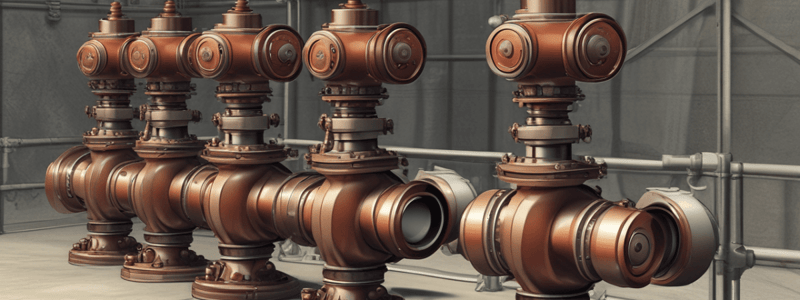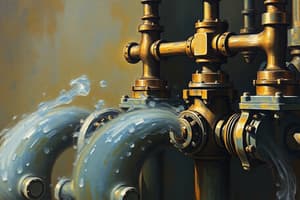Podcast
Questions and Answers
What is the primary function of the speed governor during governed operation?
What is the primary function of the speed governor during governed operation?
- To increase the engine's maximum speed
- To enhance aircraft climb performance
- To maintain a steady governed state (correct)
- To regulate fuel mixture automatically
What happens to inlet ram air pressure when an aircraft is descending?
What happens to inlet ram air pressure when an aircraft is descending?
- It decreases and mass airflow decreases
- It increases and mass airflow remains constant
- It increases and mass airflow increases (correct)
- It decreases and mass airflow increases
What component is influenced by the inlet and burner pressure bellows?
What component is influenced by the inlet and burner pressure bellows?
- Pilot servo rod valve
- Multiplying lever movement (correct)
- Power lever position
- Flyweight speeder spring
In the context of acceleration, what effect does moving the power lever upwards have on the spring cap?
In the context of acceleration, what effect does moving the power lever upwards have on the spring cap?
What occurs when the flyweights are forced into an underspeed condition?
What occurs when the flyweights are forced into an underspeed condition?
Which variable does NOT affect the operation of the engine during governed or steady operation?
Which variable does NOT affect the operation of the engine during governed or steady operation?
How does the engine react to a decrease in inlet air pressure due to climbing?
How does the engine react to a decrease in inlet air pressure due to climbing?
What is the outcome of a stable power lever position during steady operation?
What is the outcome of a stable power lever position during steady operation?
What is the main advantage of the vaporiser nozzle in combustion engines compared to atomising nozzles?
What is the main advantage of the vaporiser nozzle in combustion engines compared to atomising nozzles?
How does the vaporising nozzle discharge fuel compared to the atomiser nozzle?
How does the vaporising nozzle discharge fuel compared to the atomiser nozzle?
What is the role of the primer or starting fuel system in relation to the vaporising nozzles?
What is the role of the primer or starting fuel system in relation to the vaporising nozzles?
Which type of vaporiser nozzle has multiple outlets?
Which type of vaporiser nozzle has multiple outlets?
Why might additional atomising nozzles be used in conjunction with vaporising nozzles during engine operation?
Why might additional atomising nozzles be used in conjunction with vaporising nozzles during engine operation?
What is the primary flow characteristic of vaporising nozzles during operation?
What is the primary flow characteristic of vaporising nozzles during operation?
What is the primary function of the redundant channels in an EEC?
What is the primary function of the redundant channels in an EEC?
What happens when both channels of the EEC fail?
What happens when both channels of the EEC fail?
Which mode does the EEC enter when both channels fail and the last known ambient pressure signal is used?
Which mode does the EEC enter when both channels fail and the last known ambient pressure signal is used?
What components does the EEC control aside from the primary engine functions?
What components does the EEC control aside from the primary engine functions?
How does the EEC achieve an interface between its signal and fuel flow?
How does the EEC achieve an interface between its signal and fuel flow?
What does the Engine Rating Plug select in the EEC?
What does the Engine Rating Plug select in the EEC?
What role do dual sensors play in the EEC structure?
What role do dual sensors play in the EEC structure?
In the context of EEC functionality, what is a characteristic of the Hard Reversionary mode?
In the context of EEC functionality, what is a characteristic of the Hard Reversionary mode?
What is the primary function of a motor-driven gate valve?
What is the primary function of a motor-driven gate valve?
What advantage does a solenoid-operated valve have over a motor-driven gate valve?
What advantage does a solenoid-operated valve have over a motor-driven gate valve?
How does the solenoid valve maintain its open position after being activated?
How does the solenoid valve maintain its open position after being activated?
What triggers the low fuel pressure switch to close?
What triggers the low fuel pressure switch to close?
When a solenoid coil is energized, what effect does it have on the valve stem?
When a solenoid coil is energized, what effect does it have on the valve stem?
What must occur for the solenoid-operated valve to close after being opened?
What must occur for the solenoid-operated valve to close after being opened?
What role does the warning light in the cockpit play concerning fuel supply?
What role does the warning light in the cockpit play concerning fuel supply?
What happens to the locking plunger when the closing solenoid coil is energized?
What happens to the locking plunger when the closing solenoid coil is energized?
What happens when the power lever is opened in relation to the dump valve?
What happens when the power lever is opened in relation to the dump valve?
What is the function of the dump valve after engine shutdown?
What is the function of the dump valve after engine shutdown?
What effect does residual engine heat have on fuel if not properly managed?
What effect does residual engine heat have on fuel if not properly managed?
Under which condition does fuel start to flow into the main manifold?
Under which condition does fuel start to flow into the main manifold?
What is the purpose of the pressurising valve in the fuel system?
What is the purpose of the pressurising valve in the fuel system?
How does the construction of pressurisation and dump valves differ?
How does the construction of pressurisation and dump valves differ?
What triggers the closing of the fuel passage after the shutdown?
What triggers the closing of the fuel passage after the shutdown?
What issue does the dump valve help prevent in a gas turbine engine?
What issue does the dump valve help prevent in a gas turbine engine?
Flashcards
Shut-off Valves
Shut-off Valves
Valves that control fuel flow using electric motors or solenoids.
Motor-Driven Gate Valve
Motor-Driven Gate Valve
Regulates fuel flow using a reversible electric motor and sliding valve.
Solenoid-Operated Valve
Solenoid-Operated Valve
Valve that opens with an electric current creating a magnetic pull.
Low-Pressure Transmitters
Low-Pressure Transmitters
Signup and view all the flashcards
Governed Operation
Governed Operation
Signup and view all the flashcards
Acceleration Mechanism
Acceleration Mechanism
Signup and view all the flashcards
Electronic Engine Control (EEC)
Electronic Engine Control (EEC)
Signup and view all the flashcards
Fuel Control Integration
Fuel Control Integration
Signup and view all the flashcards
Dump Valve Functionality
Dump Valve Functionality
Signup and view all the flashcards
Pressurisation and Dump Valves
Pressurisation and Dump Valves
Signup and view all the flashcards
Vaporising Nozzles
Vaporising Nozzles
Signup and view all the flashcards
Tee-Shaped Nozzle
Tee-Shaped Nozzle
Signup and view all the flashcards
Cane-Shaped Nozzle
Cane-Shaped Nozzle
Signup and view all the flashcards
Atomising Nozzles
Atomising Nozzles
Signup and view all the flashcards
Primer System
Primer System
Signup and view all the flashcards
Reversible Electric Motor
Reversible Electric Motor
Signup and view all the flashcards
Cockpit Warning Light
Cockpit Warning Light
Signup and view all the flashcards
Pressure Bellows
Pressure Bellows
Signup and view all the flashcards
Pilot Servo Valve
Pilot Servo Valve
Signup and view all the flashcards
Engine Spool-Up
Engine Spool-Up
Signup and view all the flashcards
Fuel Flow Regulation
Fuel Flow Regulation
Signup and view all the flashcards
Engine Function Amid Faults
Engine Function Amid Faults
Signup and view all the flashcards
magnetic pull
magnetic pull
Signup and view all the flashcards
Low RPM Combustion Stability
Low RPM Combustion Stability
Signup and view all the flashcards
Engine Data Management
Engine Data Management
Signup and view all the flashcards
Study Notes
Shut-off Valves
- Common shut-off valves include motor-driven gate valves and solenoid-operated valves.
Motor-Driven Gate Valve
- Utilizes a reversible electric motor to move a sliding valve assembly.
- The motor regulates the position of the valve gate, controlling fuel flow.
Solenoid-Operated Valve
- Offers quicker actuation compared to motor-driven counterparts.
- Operates via electronic current that creates magnetic pull, opening and holding the valve until current is reversed.
Low-Pressure Transmitters
- Alerts pilots when fuel in the supplying tank runs low or a boost pump fails.
- The low fuel pressure switch closes at low pressure, activating a cockpit warning light.
Governed Operation
- Maintains steady engine operation as per pilot input regardless of external factors like aircraft speed and altitude.
- Senses inlet ram air pressure changes to adjust fuel mixture ratios through pressure bellows.
Acceleration Mechanism
- Power lever movement compresses the spring cap, affecting pilot servo valve operations and leading to engine acceleration.
Electronic Engine Control (EEC)
- Comprises two redundant processing channels that manage engine data and operation.
- Capable of continuing function amid multiple faults and switches between active and standby channels efficiently.
Fuel Control Integration
- The EEC interfaces with hydromechanical units to regulate fuel flow using various actuators, ensuring stable engine operation across different conditions.
Dump Valve Functionality
- Allows for draining fuel from manifolds post-shutdown to prevent issues like boiling or after-burning, which can cause deposits.
Operation of Pressurisation and Dump Valves
- Changes state based on power lever movement, with pressure signals managing flow to and from fuel manifolds.
Vaporising Nozzles
- Two types: tee-shaped (dual outlets) and cane-shaped (single outlet).
- Vaporisers produce a slow-moving spray, enhancing combustion stability at low RPMs; often used with atomising nozzles for starting fuel.
Primer or Starting Fuel System
- Small atomising nozzles may assist during the starting phase by injecting fuel into the combustor prior to engine spool-up.
Studying That Suits You
Use AI to generate personalized quizzes and flashcards to suit your learning preferences.




